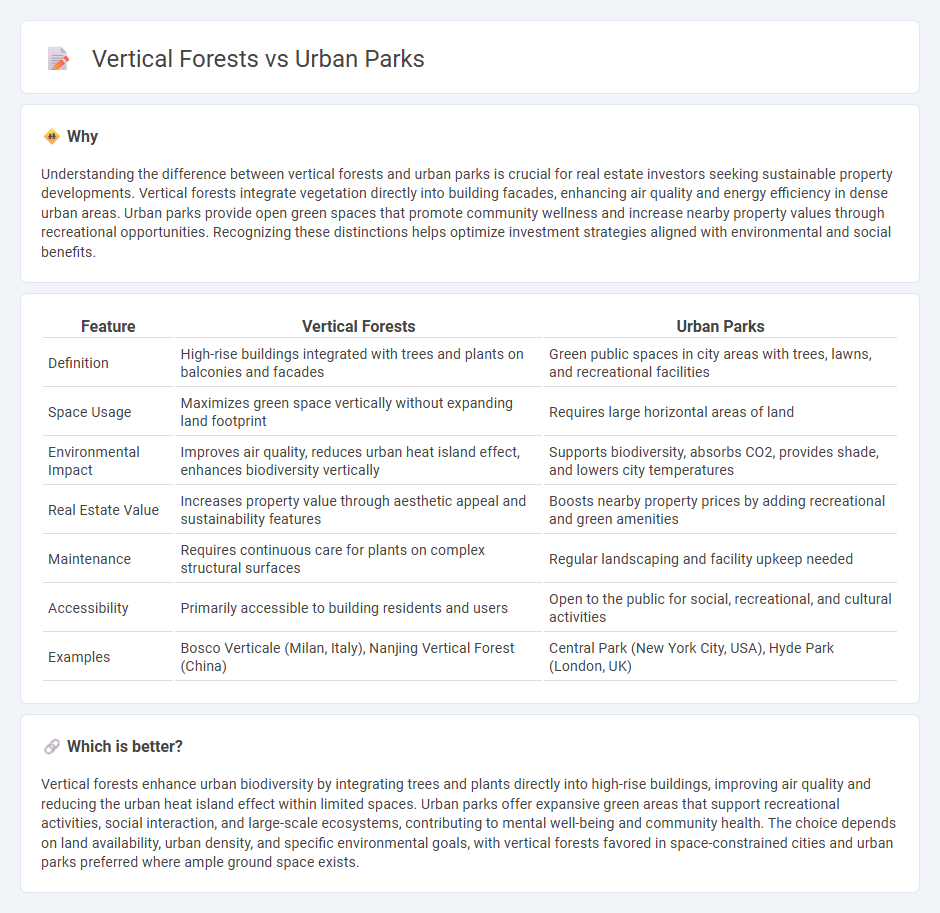
Vertical forests integrate dense vegetation directly into high-rise buildings, enhancing urban biodiversity and improving air quality more efficiently than traditional urban parks. Urban parks offer expansive green spaces for recreation and community events but often lack the concentrated environmental benefits provided by vertical greenery. Explore the distinct advantages of vertical forests and urban parks to understand their impact on sustainable city living.
Why it is important
Understanding the difference between vertical forests and urban parks is crucial for real estate investors seeking sustainable property developments. Vertical forests integrate vegetation directly into building facades, enhancing air quality and energy efficiency in dense urban areas. Urban parks provide open green spaces that promote community wellness and increase nearby property values through recreational opportunities. Recognizing these distinctions helps optimize investment strategies aligned with environmental and social benefits.
Comparison Table
| Feature | Vertical Forests | Urban Parks |
|---|---|---|
| Definition | High-rise buildings integrated with trees and plants on balconies and facades | Green public spaces in city areas with trees, lawns, and recreational facilities |
| Space Usage | Maximizes green space vertically without expanding land footprint | Requires large horizontal areas of land |
| Environmental Impact | Improves air quality, reduces urban heat island effect, enhances biodiversity vertically | Supports biodiversity, absorbs CO2, provides shade, and lowers city temperatures |
| Real Estate Value | Increases property value through aesthetic appeal and sustainability features | Boosts nearby property prices by adding recreational and green amenities |
| Maintenance | Requires continuous care for plants on complex structural surfaces | Regular landscaping and facility upkeep needed |
| Accessibility | Primarily accessible to building residents and users | Open to the public for social, recreational, and cultural activities |
| Examples | Bosco Verticale (Milan, Italy), Nanjing Vertical Forest (China) | Central Park (New York City, USA), Hyde Park (London, UK) |
Which is better?
Vertical forests enhance urban biodiversity by integrating trees and plants directly into high-rise buildings, improving air quality and reducing the urban heat island effect within limited spaces. Urban parks offer expansive green areas that support recreational activities, social interaction, and large-scale ecosystems, contributing to mental well-being and community health. The choice depends on land availability, urban density, and specific environmental goals, with vertical forests favored in space-constrained cities and urban parks preferred where ample ground space exists.
Connection
Vertical forests and urban parks both enhance urban biodiversity by incorporating greenery into city landscapes, improving air quality and reducing urban heat island effects. Vertical forests integrate trees and plants on building facades, while urban parks provide expansive green spaces, together promoting ecological sustainability and residents' well-being. These green infrastructures create interconnected habitats supporting urban wildlife and fostering environmental resilience.
Key Terms
Green Space Density
Urban parks provide extensive green space density at ground level, enhancing air quality and biodiversity by integrating large, open natural areas within city landscapes. Vertical forests increase green space density vertically by incorporating vegetation on building facades and balconies, optimizing space in densely populated urban environments and improving local microclimates. Explore how these green infrastructure solutions contribute uniquely to sustainable urban development.
Biodiversity
Urban parks support biodiversity by offering diverse habitats such as lawns, ponds, and wooded areas that attract a wide range of species including birds, insects, and small mammals. Vertical forests enhance urban biodiversity by integrating multi-layered vegetation on building facades, providing nesting sites and food sources for birds and pollinators within dense city environments. Explore further to understand how both urban parks and vertical forests uniquely contribute to sustainable biodiversity in metropolitan areas.
Urban Heat Island Effect
Urban parks significantly mitigate the Urban Heat Island (UHI) effect by providing extensive vegetation cover that cools the surrounding air through evapotranspiration and shade. Vertical forests, with dense greenery integrated into building facades, offer localized cooling benefits by reducing surface temperatures and enhancing air quality in densely built environments. Explore the comparative impact of these green solutions on urban temperature regulation and sustainability.
Source and External Links
Urban parks | EBSCO Research Starters - Urban parks are city green spaces designed for recreation and environmental awareness, emerging in the 19th century as part of efforts to improve public health, connect urbanites with nature, and reduce urban stress.
Urban park - Wikipedia - Urban parks are landscaped public spaces in cities offering residents and visitors green areas for recreation, exercise, and relaxation, with features like playgrounds, sports fields, and picnic areas, and are typically managed by local government agencies or partners.
Parks, Open Space & Trails - City of Aurora - The City of Aurora provides 103 developed parks and 8,000 acres of open space for walking, hiking, biking, fishing, and other activities, typically equipped with playgrounds, picnic tables, and trails, and open from early morning to late evening.
 dowidth.com
dowidth.com